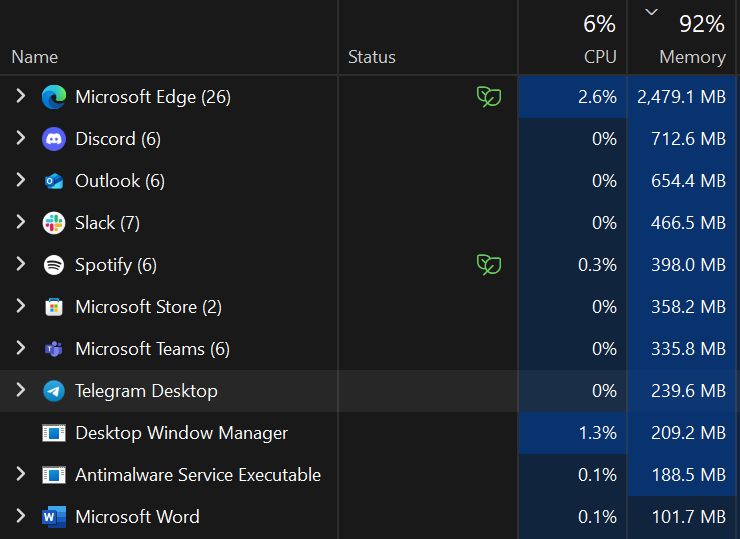
For years, 16GB of RAM was what most testers, including ourselves, would recommend consumers spring for when reading laptop reviews. 8GB was the bare minimum, but 16GB was generally the sweet spot. It was the case for well over a decade, but in the last year or so, I’ve started to notice a change.
I’m not a particularly heavy "power user", but I am someone who runs multiple apps at a time like Telegram, Slack, Word, and Outlook, paired with a dozen or so browser tabs, while blasting Spotify with some occasional lightweight photo or video editing. I'd consider this to be a relatively normal, non-intensive workflow.
A few years ago, 16GB of RAM felt like more than enough for this kind of Windows PC usage. But today, as desktop apps become heavier and more demanding, it's no longer the case. Outlook, Slack, and Spotify are all Electron (JavaScript) apps that sometimes demand anywhere from 500MB to 1GB of RAM each.
As a result, 16GB of RAM is now the bare minimum, especially if you’re springing for an AI laptop, like a certified Copilot+ PC. I often notice my PC running with around 95% of RAM utilization, and I’m not doing anything super intensive to achieve that. Of course, memory is there to be used, but I’d feel better if I had a little bit of headroom.

The problem is, I’ve daily-driven laptops with 32GB of RAM, and I almost never utilize all of it. I don’t have a single workflow on my PC that can achieve anywhere close to 90% utilization with 32GB of RAM. At most, I’m using 20GB, which leads me on to Apple's hardware and why I think 24GB RAM is the new sweet spot.
When configuring a new Mac, you have the option to upgrade from 16GB of RAM to 24GB or 32GB. It's a nice option, as it means you can save a bit of money if you know your workflow. Most people, including myself, don’t need 32GB of RAM, but 16GB isn’t enough anymore for future-proofed longevity.
Whenever I buy a laptop with only 16GB or 32GB RAM options, I feel like I’m throwing money away when I spring for the 32GB model because I’m not utilizing it to its full potential. 24GB really is the sweet spot right now, and if I can save $200 by going for 24GB instead of 32GB, I’m absolutely taking it.
Except, in the Windows world, 24GB RAM configurations aren’t super common in laptops. Microsoft’s soon-to-expand Surface line, for example, does not offer 24GB RAM configurations at all. They do exist in the wider PC space, though they’re not consistent and often not on the flagship Ultrabook-class laptops from big-name OEMs.

When I purchased my Surface Laptop 7 last year, I foolishly opted for the config with 16GB of RAM as there was a £400 delta between the 16GB and 32GB model, and I just couldn’t justify the extra cost because I knew I didn’t need 32GB. Had there been a 24GB option for just £200 more, I would have absolutely gone for that.
Apple seems to offer 24GB RAM configs in pretty much all its Macs, sometimes in lieu of a 32GB option. Apple controls everything from the silicon down, which is why it’s able to do this, and Windows OEMs don’t always have the same luxury.
To be clear, I’m not saying the baseline needs to be upped to 24GB. I think 16GB of RAM is still plenty for many people and should be the baseline for many years to come. However, I think there are a lot of us out there who are already feeling the constraints with 16GB but can’t justify the extra money to upgrade to 32 GB.
24GB is the sweet spot.
Now, I’m stuck with a laptop that’s already close to reaching its RAM limit. I know I’m not the only one in this situation, and I think Windows OEMs and chipmakers need to push to offer 24GB RAM configs in more products going forward.
What do you think? Should Windows laptops have more 24GB RAM options? Let me know your thoughts in the comments.







